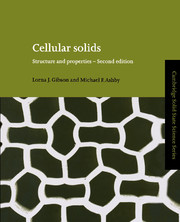Book contents
- Frontmatter
- Contents
- Preface to the second edition
- Preface to the first edition
- Units and conversion tables
- Chapter 1 Introduction
- Chapter 2 The structure of cellular solids
- Chapter 3 Material properties
- Chapter 4 The mechanics of honeycombs
- Chapter 5 The mechanics of foams: basic results
- Chapter 6 The mechanics of foams: refinements
- Chapter 7 Thermal, electrical and acoustic properties of foams
- Chapter 8 Energy absorption in cellular materials
- Chapter 9 The design of sandwich panels with foam cores
- Chapter 10 Wood
- Chapter 11 Cancellous bone
- Chapter 12 Cork
- Chapter 13 Sources, suppliers and property data
- Appendix: The linear-elasticity of anisotropic cellular solids
- Index
- References
Chapter 10 - Wood
Published online by Cambridge University Press: 05 August 2014
- Frontmatter
- Contents
- Preface to the second edition
- Preface to the first edition
- Units and conversion tables
- Chapter 1 Introduction
- Chapter 2 The structure of cellular solids
- Chapter 3 Material properties
- Chapter 4 The mechanics of honeycombs
- Chapter 5 The mechanics of foams: basic results
- Chapter 6 The mechanics of foams: refinements
- Chapter 7 Thermal, electrical and acoustic properties of foams
- Chapter 8 Energy absorption in cellular materials
- Chapter 9 The design of sandwich panels with foam cores
- Chapter 10 Wood
- Chapter 11 Cancellous bone
- Chapter 12 Cork
- Chapter 13 Sources, suppliers and property data
- Appendix: The linear-elasticity of anisotropic cellular solids
- Index
- References
Summary
Introduction and synopsis
Wood is the most ancient, but still the most widely used, structural material in the world – indeed – the word ‘material’ itself derives from the Latin materies, materia: the trunk of a tree. The use of wood in buildings, ships and furniture is as old as the pyramids – wooden artefacts at least 5000 years old have been found in them. During the sixteenth century the demand in Europe for stout oaks for shipbuilding was so great that the population of suitable trees was depleted; by the seventeenth century ships' timbers had to be imported into England from the New World. By 1800 much of Europe had been deforested by the exponential growth in the consumption of wood, a problem that programmes of reforestation have only partly overcome. Today the world production of wood is roughly the same as that of iron and steel: roughly 109 tonnes per year. This production finds many uses, in everything from musical instruments to pit props. Table 10.1 lists some of these, with the species of wood best suited for each. Much of the total production is used structurally: for beams, joists, flooring and supports which bear load. Then the properties which interest the designer are the moduli, the crushing strength and the toughness. These properties vary enormously from one wood to another: oak is more than 10 times stiffer, stronger and tougher than balsa.
- Type
- Chapter
- Information
- Cellular SolidsStructure and Properties, pp. 387 - 428Publisher: Cambridge University PressPrint publication year: 1997
References
- 2
- Cited by



